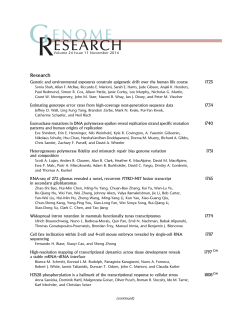
ç覽
2015 年中央研究院年輕學者研究著作獎得獎人簡介 ─數理科學組─ 楊舒芝 國立中央大學大氣科學學系副教授 代表作名稱: ★ S.-C. Yang*, S.-Y. Chen, S.-H. Chen, C.-Y. Huang and C.-S. Chen. “Evaluating the Impact of the COSMIC-RO Bending Angle Data on Predicting the Heavy Precipitation Episode on 16 June 2008 during SoWMEX-IOP8.” Monthly Weather Review 142 (2014): 4139-4163. ★ S.-C. Yang*, K.-J. Lin, T. Miyoshi and E. Kalnay. “Improving the Spin-up of Regional EnKF for Typhoon Assimilation and Forecasting with Typhoon Sinlaku (2008).” Tellus A 65 (2013): 25804. ★ S.-C. Yang*, E. Kalnay and B. Hunt. “Handling Nonlinearity and Non-Gaussianity in Ensemble Kalman Filter.” Monthly Weather Review 140 (2012): 2628-2646. 得獎簡評: 楊舒芝博士目前任教於國立中央大學大氣科學學系,她的專長領域是大氣的資料同 化(data assimilation)。現代的天氣及氣候預報幾乎都是利用數值預報模式的推算來進 行,而預報模式的初始條件便是某一特定時段的實際大氣狀況。然而這些實際狀況卻是 從各式各樣的觀測儀器及平臺:諸如傳統的溫度、氣壓、濕度計,乃至探空氣球、飛機、 雷達、光達(lidar)、同步衛星、繞極衛星等等,其記錄之資料形態、時空涵蓋度、解析 度、精準度之更是十分龐雜不齊,此類未同化之資料作為初始條件勢必引入極大誤差, 使得預報結果不堪運用。如何使這些龐雜的資料以統一而準確的形式進入預報模式中, 便是資料同化的複雜計算課題。楊博士提出獨特的 RIP(Running-in-place)及準外圈法 (Quasi-Outer Loop, QOL),而改善了此領域中的中心工具卡爾曼濾波器(Kalman Filter)的 一些缺點,增進了資料同化運算的效率,也實質導致了數值天氣預報的準確率。 得獎人簡歷: Prof. Shu-Chih Yang received her Ph.D. degree from Department of Atmospheric and 2015 年中央研究院年輕學者研究著作獎得獎人簡介 ─數理科學組─ Oceanic Science in University of Maryland under Prof. Eugenia Kalnay. Her research interest is to study dynamical predictability through data assimilation methods and ensemble forecasting. She investigates methods and strategies for applying Ensemble Kalman filter (EnKF) to numerical weather prediction and justifies the newly proposed methods with complex dynamic models and real cases. To tackle issues related to realistic applications of EnKF, Prof. Yang and her collaborator, Prof. Kalnay, proposed methods to improve EnKF’s performance under strong nonlinear dynamics or long spin-up (Yang et al. 2012, Kalnay and Yang, 2010). Recently, Prof. Yang has been focusing on improving the severe weather prediction in Taiwan. She coupled the Local Ensemble Kalman Transform Filter with the Weather and Research Forecasting model and developed the NCU-regional Ensemble-based Data Assimilation System (NCU-REAS) to study the meso-small scale predictability and severe weather prediction in Taiwan. She leads the NCU-REAS team and collaborates with international and local experts to expand the developments and applications of this system. The research based on NCU-REAS mainly focuses on improving the system performance by new assimilation methods and investigating the observation impact for severe weather prediction in Taiwan. She applied the NCU-REAS system to study the EnKF’s spin-up problem for typhoon assimilation and improved the typhoon prediction during the early stage of typhoon development (Yang et al. 2012, 2013a). She also explores observations impact for severe precipitation forecast. With Profs. Shu-Hua Chen, Ching-Yuan Huang and Cing-Sen Chen, they investigate the impact of COSMIC RO data on improving the heavy precipitation prediction during the Mei-Yu front (Yang et al. 2014). Based on NCU-REAS, she also works with Prof. Yu-Ching Liou and their co-advised Ph.D. student, Dr. Justin Tsai, to establish the radar assimilation system to improve the quantitative precipitation nowcasting in Taiwan (TsaiYangLiou, 2013). Recently, she works with Dr. Hui-Ling Chang to evaluate the performance of the operational ensemble prediction system in terms of the social impact, linking the forecast skill with the economic value (Chang et al., 2015). 代表作簡介: The EnKF is optimal only for linear models because it assumes Gaussian distributions. When the Gaussian assumption is severely violated due to strong nonlinear error growths, filter divergence occurs and the ability to assimilate observations is hindered, limiting the performance of the numerical model prediction. Strong nonlinear error growths often occur in the strong meso-small scale convections like rapidly developing storms, or when the dynamical flow at the transition periods to change regimes like from El Niño to La Niña. In the work of Yang et al. (2012), Prof. Yang and Profs. Eugenia Kalnay and Brian Hunt jointly proposed a new type of outer-loop to improve the ability of EnKF to handle nonlinear 2015 年中央研究院年輕學者研究著作獎得獎人簡介 ─數理科學組─ evolving dynamics, especially for long assimilation windows. They proposed that the Running-In-Place method could serve as a “general outer-loop” within the LETKF framework. When there is strong nonlinear error growth, the observation influence can be increased by re-using observations and thus the ensemble mean and perturbations can be both improved. In addition, considering the computation cost of RIP due to multiple ensemble forecasts, the Quasi-Outer-Loop (QOL) algorithm is further proposed as a simplified version of RIP and aims to improve the ensemble mean so that ensemble perturbations are centered at a more accurate state. Results with the Lorenz 3-variable model show that both the RIP and QOL methods allow the LETKF to better assimilate infrequent observations and provide significant improvements of the analysis accuracy during periods of high nonlinear growth. In the work of Yang et al. (2013), Prof. Yang and her collaborators further conducted a real case study with Typhoon Sinlaku in 2008 and demonstrated that the RIP method can advances the assimilation efficiency and successfully improve the track prediction during the typhoon developing stage (also the EnKF’s spin-up). The value of the dropsonde data during the early stage of typhoon can be further increased with this method, since they are now more effectively used. Most importantly, this study also demonstrates that the RIP method can serve as a general outer-loop scheme for EnKF so that the assimilation system can better handle the conditions like highly uncertain environment for typhoon development (e.g. strong nonlinear dynamics) as proposed in Yang et al. (2012). For realist applications, Prof. Yang implements the operators for simulating radio occultation (RO) data in NCU-REAS and investigates the impact of COSMIC-RO refractivity and bending angle data on predicting an extreme precipitation event on 16 th June, 2008. Yang et al. (2014) demonstrates that with the advantage of flow-dependent background errors, the system can detect the differences in assimilation the refractiviy or bending angle data. The former is related to the amount of moisture and the latter is sensitive to the vertical variations of the moisture. Results show that assimilation of bending angle can further improve the moisture distribution in the low atmosphere and enhance the moisture transport from South China Sea when the south-westerly jet is active. With the moisture adjustment from the RO data, the location and intensity of rainfall prediction is greatly improved and the system can successfully predict the heavy precipitation in the coastal area of southwestern Taiwan. 得獎感言: 謝謝中研院提供鼓勵年輕科學家的獎項,舒芝深感榮幸能獲得此殊榮。感謝中央大 學,地球科學院及大氣系對我長久以來的支持與栽培,支持我發展本土資料同化技術, 改善劇烈天氣預報的夢想。也特別感謝我的父母,兩位姊姊,先生,女兒及兒子,因為 你們所有研究成果的滋味才是甜美的。此外,我也要感謝我的合作夥伴們,助理,及研 究生,願意幫助我,陪著我打拼讓夢想發芽茁壯。最後謝謝我生命中的貴人 Eugenia Kalnay 教授。
© Copyright 2025











